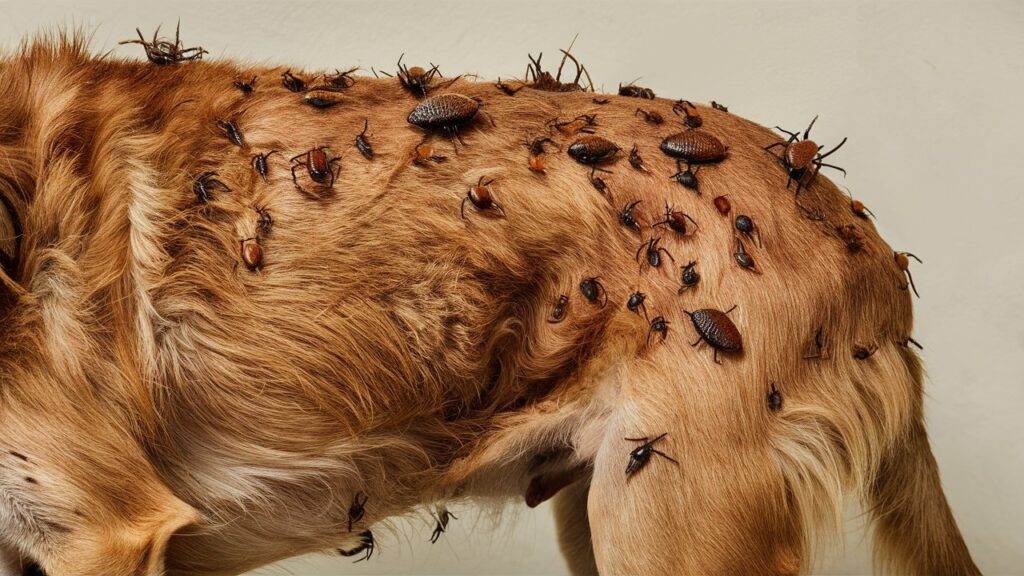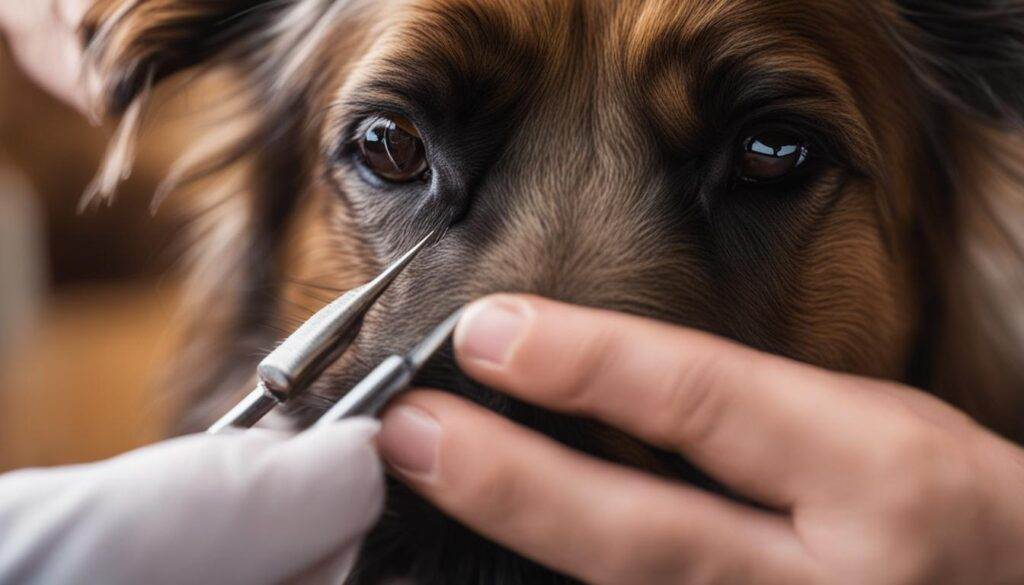Discover the common types of ticks on dogs in India and understand the tick-borne diseases they can cause. Learn effective dog tick prevention and removal methods to keep your dog healthy.
Understanding Dog Ticks in India
Types of Ticks Found in India
In India, dog owners should know about the different types of ticks that can bother their pets. There are two main kinds: hard ticks and soft ticks.
Hard Ticks
One common hard tick is the Brown Dog Tick (Rhipicephalus sanguineus). You can find these ticks in cities and countryside. They hold on tight to dogs and can spread diseases, which is a big worry for dog health.
Soft Ticks
Soft ticks aren’t seen as much, but they can still be a problem for dogs. They usually feed quickly and can be trickier to find because their bodies are softer. It’s really important to know what types of ticks live near you so you can keep your pet safe.
Knowing about these tick types helps pet owners take better care of their furry friends.
Common Characteristics of Dog Ticks
Spotting dog ticks early is super important! Here are some things to look out for:
- Shape: When they haven’t fed yet, dog ticks look like flat ovals. After they eat, they get round and puffy.
- Color: They change color too! They can be brown or black, and after a meal, they might even look grayish.
- Mouthparts: Ticks have special mouth parts that help them stick on tight while they eat.
If you notice these signs, it’s time to act fast!
Importance of Tick Identification for Diagnosis and Prevention
Figuring out what kind of tick is on your dog is really important. Different ticks carry different germs that can make dogs sick.
For example, Brown Dog Ticks can spread Canine Ehrlichiosis and Babesiosis. Knowing which tick it is helps vets suggest the right treatments for your dog’s health.
Regular visits to the vet also help you learn about local tick types and when they’re most active. This info gives pet owners better tools to fight off these pesky bugs!
Learning about the types of ticks that affect dogs in India is a key step in keeping your pet healthy. By spotting these pests correctly and knowing how dangerous they can be, you’ll be able to use good prevention methods that help your dog’s overall well-being.
Tick-Borne Diseases in Dogs in India
Tick-Borne Diseases Caused by Hard Ticks
Hard ticks are bad news for dogs. They can carry some serious sicknesses. One big one is Canine ehrlichiosis. This disease comes from a germ called Ehrlichia canis. If a dog gets this and it’s not treated, it can get really sick. Look out for signs like:
- Fever
- Feeling very tired
- Not wanting to eat
If you see these signs, take your dog to the vet right away!
Another nasty tick-borne disease is Canine babesiosis. This one is caused by tiny bugs called protozoan parasites that ticks spread when they bite. Dogs with this might show symptoms like:
- Fever
- Weakness (anemia)
- Yellow skin (jaundice)
Getting help from a vet quickly can make a big difference for dogs that are sick.
Then there’s Canine anaplasmosis, which comes from another germ called Anaplasma phagocytophilum. This disease messes with a dog’s white blood cells and can cause:
- Joint pain
- Fever
Regular vet visits and knowing about these diseases are super important for keeping your dog safe.
Tick-Borne Diseases Caused by Soft Ticks
Soft ticks aren’t as common as hard ticks in India, but they can still make dogs sick. One illness linked to soft ticks is relapsing fever. This means the dog has high fevers that come and go. If you think your dog might have been around soft ticks, keep an eye on its health.
Even though Lyme disease isn’t very common in India, it’s something to watch out for if you travel or live where it could be found. Signs of Lyme disease include:
- Limping
- Tiredness (fatigue)
Spotting these signs early helps manage the problem better.
Prevention Strategies Against Tick-Borne Diseases
Keeping your dog safe from tick-borne diseases should be a top priority! Here are some easy ways to do that:
- Use Tick Prevention Products: Collars or creams that keep ticks away are really helpful.
- Regular Grooming: Brush your dog often so you can check for any ticks hiding in its fur.
- Keep Your Yard Clean: Mow the grass and clear away any junk outside to stop ticks from hanging around.
- Learn About Local Ticks: Knowing what types of ticks live near you helps spot risks faster.
By doing these things, you can help keep those pesky ticks away and protect your furry friend!
Awareness and Vigilance
Being aware of tick-borne diseases is key to keeping your dog healthy in India. Talk to veterinarians about what kinds of tick problems are common where you live; they can give good advice on how to protect your pet based on local risks. Regular check-ups at the vet help catch any issues before they become serious.
Staying informed and taking action helps keep your beloved pet safe from tick-related illnesses!

Prevention of Tick Infestations in Dogs
Chemical Tick Prevention Methods
To keep your dog safe from ticks, chemical methods are often the best choice. These products can kill or keep ticks away from your pet. Here are some popular options:
- Tick Collars: These collars let out chemicals that can repel and kill ticks right away. Make sure to pick a collar that fits well and is good for your dog’s size and age.
- Topical Tick Treatments: These are liquid medicines put directly on your dog’s skin, usually between the shoulder blades. They protect against both ticks and fleas for a long time.
- Oral Tick Medications: Chewable tablets help stop ticks from latching onto your dog. They’re easy to give and many pet owners find them simpler than topical treatments.
- Fipronil-based Spot-On: This treatment works well against fleas and ticks, giving lasting protection.
- Cypermethrin Shampoos: Using these shampoos when you bathe your dog can help wash away any existing ticks while also preventing new ones.
- Propoxur Powders: Sprinkling this powder on your dog’s coat can help get rid of ticks effectively.
Always talk to a veterinarian before starting any chemical prevention method to make sure it’s right for your dog’s health.
Natural Tick Prevention Methods
If you like natural solutions, there are ways to prevent ticks without chemicals:
- Essential Oils: Some oils like lavender, eucalyptus, and cedarwood can keep ticks away. Just remember to dilute these oils before putting them on your dog’s fur or skin.
- Home Remedies: Simple mixtures like vinegar or lemon juice mixed with water can help deter ticks when sprayed on your dog’s coat before walks in areas where ticks might be hiding.
Natural methods may not work as strongly as chemical options but they can be used together for better safety.
Environmental Tick Prevention
Making sure the environment around your home is safe is key to stopping tick infestations:
- Yard Maintenance: Keep the grass cut short and trim bushes regularly to reduce places where ticks can hide. You might want to create a barrier of wood chips or gravel between wooded areas and play spots for dogs.
- Cleaning Dog Bedding: Wash your dog’s bedding often in hot water to get rid of any possible ticks or eggs that could be hiding there.
- Professional Pest Control for Ticks: If you live where there are lots of ticks, think about hiring pest control experts who know how to treat yards safely against these pests.
By mixing these environmental tips with personal prevention steps for your dog, you can greatly lower the chance of tick infestations all year round.

Effective Tick Removal on Dogs
Safe Tick Removal Techniques
Removing ticks from dogs is super important. If you do it right, you can help your furry friend stay healthy and happy. Here are some easy ways to remove ticks:
- Using Tick Tweezers: Grab the tick as close to your dog’s skin as you can. Pull it out steadily and don’t twist! This helps make sure you get the whole tick, including its mouthparts. This method is great for dog tick removal.
- Using a Tick Removal Tool: There are special tools just for removing ticks! These tools slide under the tick and lift it out gently, making it easier and less scary for your dog.
- Seeking Professional Help for Embedded Ticks: If a tick is stuck deep in your dog’s skin or if you’re not sure how to take it out safely, it’s best to go see a vet. They know how to handle these situations without hurting your pet.
Post-Removal Care for Dogs
After you’ve removed the tick, taking care of your dog is really important:
- Monitoring for Tick-Borne Diseases: Keep an eye on your dog in the weeks after a tick bite. Watch for signs like tiredness, not wanting to eat, fever, or acting differently. Catching these symptoms early can help a lot!
- Thoroughly Cleaning the Tick Attachment Site: Make sure to clean where the tick was attached with soap and water or antiseptic. This helps prevent infection. Also, check that spot often for any redness or swelling.
By following these steps after removing a tick, you can lower the chances of any problems happening later on.
Additional Tips on Effective Tick Management
Besides knowing how to take off ticks safely, here are some tips to keep them away:
- Dog Grooming for Ticks: Regularly brushing your dog’s fur helps find ticks before they become a big issue. It also keeps their coat nice and clean!
- Preventing Tick Infestations: Using flea and tick medication made just for dogs can help protect them from getting ticks again in the future.
By being smart about managing ticks through good removal methods and prevention tips, you can keep your dog’s health safe from these pesky bugs!

